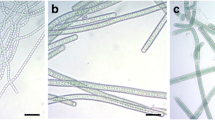Abstract
The application of antibiotic treatment with assistance of metabolomic approach in axenic isolation of cyanobacterium Nostoc flagelliforme was investigated. Seven antibiotics were tested at 1–100 mg L−1, and order of tolerance of N. flagelliforme cells was obtained as kanamycin > ampicillin, tetracycline > chloromycetin, gentamicin > spectinomycin > streptomycin. Four antibiotics were selected based on differences in antibiotic sensitivity of N. flagelliforme and associated bacteria, and their effects on N. flagelliforme cells including the changes of metabolic activity with antibiotics and the metabolic recovery after removal were assessed by a metabolomic approach based on gas chromatography–mass spectrometry combined with multivariate analysis. The results showed that antibiotic treatment had affected cell metabolism as antibiotics treated cells were metabolically distinct from control cells, but the metabolic activity would be recovered via eliminating antibiotics and the sequence of metabolic recovery time needed was spectinomycin, gentamicin > ampicillin > kanamycin. The procedures of antibiotic treatment have been accordingly optimized as a consecutive treatment starting with spectinomycin, then gentamicin, ampicillin and lastly kanamycin, and proved to be highly effective in eliminating the bacteria as examined by agar plating method and light microscope examination. Our work presented a strategy to obtain axenic culture of N. flagelliforme and provided a method for evaluating and optimizing cyanobacteria purification process through diagnosing target species cellular state.





Similar content being viewed by others
References
Andersen RA (ed) (2005) Algal culturing techniques. Elsevier, Amsterdam, pp 117–132
Cho JY, Choi JS, Kong IS, Park SI, Kerr RG, Hong YK (2002) A procedure for axenic isolation of the marine microalga Isochrysis galbana from heavily contaminated mass cultures. J Appl Phycol 14:385–390
Choi GG, Bae MS, Ahn CY, Oh HM (2008) Induction of axenic culture of Arthrospira (Spirulina) platensis based on antibiotic sensitivity of contaminating bacteria. Biotechnol Lett 30:87–92
Christian GB, Peter GK (2009) Protocols for the removal of bacteria from freshwater benthic diatom cultures. J Phycol 45:981–986
Connell L, Cattolico RA (1996) Fragile algae: axenic culture of field-collected samples of Heterosigma carterae. Mar Biol 125:421–426
Dodds WK, Gudder DA, Mollenhauer D (1995) The ecology of Nostoc. J Phycol 31:2–18
Dubois M, Gilles KA, Hamilton JK, Rebers P, Smith F (1956) Colorimetric method for determination of sugars and related substances. J Anal Chem 28:350–356
Gang-Guk C, Myong-Sook B, Chi-Yong A, Hee-Mock O (2007) Induction of axenic culture of Arthrospira (Spirulina) platensis based on antibiotic sensitivity of contaminating bacteria. Biotechnol Lett 30:87–92
Gao K, Ye C (2007) Photosynthetic insensitivity of the terrestrial cyanobacterium Nostoc flagelliforme to solar UV radiation while rehydrated or desiccated. J Phycol 43:628–635
Hall DO, Rao KK (1994) Photosynthesis. The Press Syndicate of Cambridge, London
Han PP, Yuan YJ (2009) Metabolic profiling as a tool for understanding defense response of Taxus cuspidata cells to shear stress. Biotechnol Prog 25:1244–1253
Jia SR, Yao J, Tan ZL, Yue SJ, Xu P, Qiao CS, Su JY (2008) The preparation method for Nostoc flagelliforme cells and Nostoc flagelliforme extract with anti-oxidant activity. Chinese issued patent ZL200810152297.8
Kanekiyo K, Lee JB, Hayashi K, Takenaka H, Hayakawa Y, Endo S, Hayashi T (2005) Isolation of an antiviral polysaccharide nostoflan from a terrestrial cyanobacterium Nostoc flagelliforme. J Nat Prod 68:1037–1041
Khoo SH, Al-Rubeai M (2007) Metabolomics as a complementary tool in cell culture. Biotechnol Appl Biochem 47:71–84
Liang W, Zhou Y, Wang L, You X, Zhang Y, Cheng CL, Chen W (2012) Ultrastructural, physiological and proteomic analysis of Nostoc flagelliforme in response to dehydration and rehydration. J Proteomics 75:5604–5627
Lu S, Wang J, Niu Y, Yang J, Zhou J, Yuan YJ (2012) Metabolic profiling reveals growth related fame productivity and quality of Chlorella sorokiniana with different inoculum sizes. Biotechnol Bioeng 109:1651–1662
Nola MC, Smaglinski ST, Smith GD (1992) Methods involving light variation for isolation of cyanobacteria: characterization of isolates from Central Australia. Appl Environ Microbiol 58:3561–3566
Qian KX, Zhu HR, Chen SG (1989) The ecological conditions for Nostoc flagelliforme and their analysis. Acta Phytoecol Geobot Sin 13:97–105
Qian H, Li J, Pan X, Sun Z, Ye C, Jin G, Fu Z (2012) Effects of streptomycin on growth of algae Chlorella vulgaris and Microcystis aeruginosa. Environ Toxicol 27:229–237
Qiu BS, Gao KS (2001) Photosynthetic characteristics of the terrestrial blue-green alga, Nostoc flagelliforme. Eur J Phycol 36:147–156
Raleigh EA, Elbing K, Brent R (2002) Selected topics from classical bacterial genetics. In: Ausubel FM, Brent R, Kingston RE, Moore DD, Sediman JG, Smith JA, Struhl K et al (eds) Current protocol in molecular biology, chap 1 unit 1.4. Wiley, New York
Sena L, Rojas D, Montiel E, González H, Moret J, Naranjo L (2011) A strategy to obtain axenic cultures of Arthrospira spp. Cyanobacteria. World J Microbiol Biotechnol 27:1045–1053
Suresh PT, Raman MK, Ramamurthy V (1994) Obtaining axenic culture of filamentous cyanobacterium. Biotechniques 6:216–217
Vázquez-Martínez G, Rodriguez MH, Hernández-Hernández F, Ibarra JE (2004) Strategy to obtain axenic cultures from field-collected samples of the cyanobacterium Phormidium animalis. J Microbiol Methods 57:115–121
Zhu J, Wang J, Hua Z, Martin M (1998) Ultrastructure of the vegetative cells of Nostoc flagelliforme prepared with high pressure freezing and freeze substitution technique. Acta Bot Sin 40:901–905
Acknowledgments
This research was supported by National Natural Science Foundation of China (Grant Nos. 31201405 and 31271809) and Changjiang Scholars and Innovative Research Team in University (IRT1166).
Author information
Authors and Affiliations
Corresponding author
Rights and permissions
About this article
Cite this article
Han, Pp., Jia, Sr., Sun, Y. et al. Metabolomic approach to optimizing and evaluating antibiotic treatment in the axenic culture of cyanobacterium Nostoc flagelliforme . World J Microbiol Biotechnol 30, 2407–2418 (2014). https://doi.org/10.1007/s11274-014-1666-4
Received:
Accepted:
Published:
Issue Date:
DOI: https://doi.org/10.1007/s11274-014-1666-4




